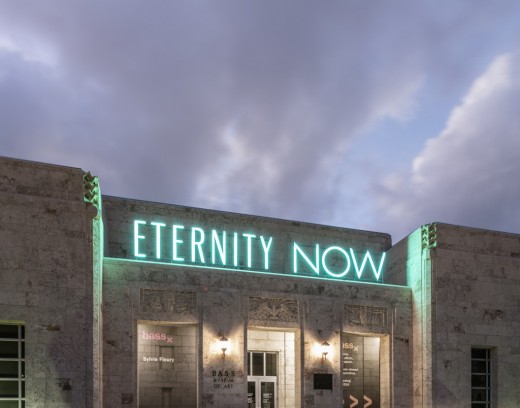 Sylvie Fleury, Eternity Now, 2015. Neon, 91.5 x 122 cm. Courtesy Bass Museum of Art. Photo: Silvia Ros
Sylvie Fleury, Eternity Now, 2015. Neon, 91.5 x 122 cm. Courtesy Bass Museum of Art. Photo: Silvia Ros
DECEMBER 2, 2015–MAY 31, 2016
Calvin Klein launched the fragrance ETERNITY NOW in July 2015, likening the scent to “the thrill and raw emotion of new love, when two people realize that it is the beginning of forever.” For a drop of liquid to capture such intangibles requires a designer’s facility and imagination, as well as a consumer’s purse. For a tidy $46, Calvin Klein can deliver dreams—on the condition they aren’t questioned.
While Calvin Klein endeavors to spin fantasies, Sylvie Fleury works to rattle them. Fleury exuberantly promotes paradoxes, simultaneously catechizing and affirming brand-name aesthetics. In her Eternity Now, a site-specific neon work installed on the Bass Museum of Art’s facade, she appropriates the fragrance’s unmistakable logo, cross-examining the syrupy expression even as the scent of commercialism emanates from the neon. The artist flirts with the Bass Museum site, at once enhancing and corrupting the historically designated building.
Eternity Now, part of bassX, the Bass Museum’s yearlong project series, entices you to enter the museum, though it is currently closed for renovations. The 1930s Art Deco building was designed by Russell Pancoast, grandson of Miami Beach pioneer John Collins. Fleury has a knack for sniffing out patriarchal tradition, even in contemporary-obsessed Miami, and then profaning it with an I-shop-therefore-I-am attitude. (She once scattered high-heeled shoes over a Carl Andre work, a gesture the older male artist censured. She responded with a video of women in their “feminine” footwear strolling across various Andre works.)
Fleury first knocked off the “Eternity” brand in 1996 and, with this work, follows Calvin Klein’s serial rehashing of it (there was Eternity Summer, Eternity Moment, Eternity Aqua . . .). Fleury reveals the fashion designer’s persistent, oxymoronic conjure of a fleeting-but-forever moment not as desire but as unpleasant contradiction. Would we really want to face our destiny at this moment? Is the future somehow better than the present?
I first saw Eternity Now on a rainy afternoon during Miami Art Week on a respite from the Convention Center’s stultifying air. A few hours later, I would be calf-deep in flooded streets, a reminder of the impending rising sea levels that will one day drown us out. On this day, Fleury’s work transformed an advertisement for ETERNITY NOW—the liquid of new love—into a suggestion of our liquefied future. Not to worry, however. Until the moment our dystopian dread becomes a reality, Fleury would have us light up the sky, splash through puddles in our shiny heels, and kick down the doors of old, inaccessible buildings.









